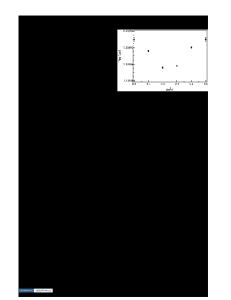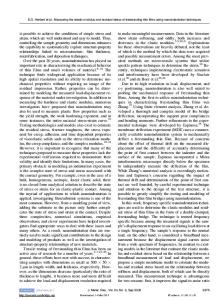Measuring residual stress in glasses and ceramics using instrumented indentation
- PDF / 1,096,560 Bytes
- 13 Pages / 585 x 783 pts Page_size
- 33 Downloads / 4,292 Views
Instrumented indentation has yielded mixed results when used to measure surface residual stresses in metal films. Relative to metals, many glasses and ceramics have a low modulus-to-yield strength (E/y) ratio. The advantage of this characteristic for measuring residual stress using instrumented indentation is demonstrated by a series of comparative spherical and conical tip finite element simulations. Two cases are considered: (i) a material with E/y ⳱ 24—similar to glass and (ii) a material with E/y ⳱ 120—similar to metal films. In both cases, compressive residual stress shifts the simulated load–displacement response toward increasing hardness, irrespective of tip geometry. This shift is shown to be entirely due to pile up for the “metal” case, but primarily due to the direct influence of the residual stress for the “glass” case. Hardness changes and load–displacement curve shifts are explained by using the spherical cavity model. Supporting experimental results on stressed glasses are provided.
I. INTRODUCTION
Residual stresses readily develop during thermal processing, joining, or sintering operations involving glasses and ceramics used for engineered microsystems components.1 These stresses may promote premature failure or long-term reliability problems in packaged microsystems, driving the need to develop methods to measure and mitigate them. One possible method is instrumented indentation; a large number of investigations have been undertaken to examine the indentation response of primarily metal surfaces or films under residual stress.2–12 Thus, instrumented indentation may offer an intriguing possibility as a straightforward and inexpensive method for measuring and mapping residual stresses at the micron-size scale for glass or ceramic coatings and for microsystem components made of brittle materials. Instrumented indentation residual stress measurement investigations rely on a measurable difference in the indentation load–displacement response between stressed and unstressed materials that are otherwise identical.3,6 A popular quantitative model, derived from the finite element simulation results given by Bolshakov et al.6 was proposed by Suresh and Giannakopoulous.7 The model attributes the measurable differences in the indentation load–displacement response to the indentation contact a)
Address all correspondence to this author. e-mail: [email protected] DOI: 10.1557/JMR.2007.0358
area and attempts to elicit values of the residual stress from differences in load in depth-controlled experiments. A degree of success using this technique was demonstrated analytically through additional finite element simulations 8 and experimentally using single-edge notched Al alloy beams stressed using three- and fourpoint bend test configurations.9 Carlsson and Larsson8,9 also considered the influence of work hardening induced by plastic strain on the instrumented indentation measurement. Other investigations have been less certain regarding the original analysis proposed by Suresh and Giannakopoulous, suggestin
Data Loading...











